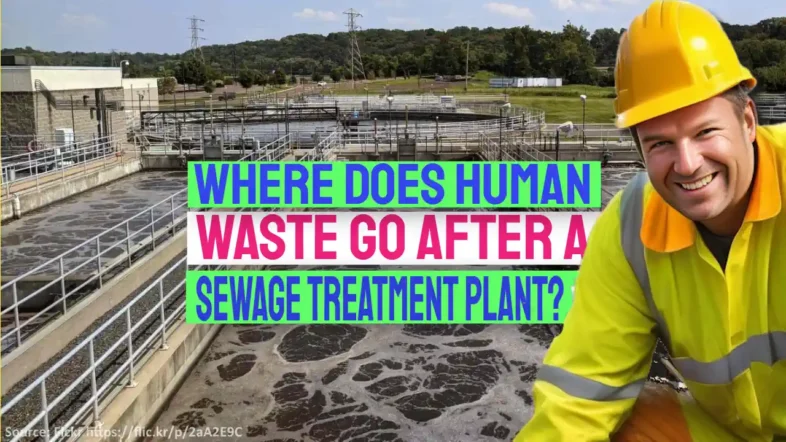Have you ever wondered what happens to the water and waste after you flush the toilet? And, also, what happens to human waste after a sewage treatment plant? These are things we rarely think about, but it plays a crucial role in keeping our environment clean and safe.
Every day, millions of litres of wastewater are produced by homes, schools, offices, and factories. This dirty water carries everything from leftover food particles to human waste, and it flows from houses, offices, factories etc., down into the sewers.
One interesting fact is that this wastewater doesn't just disappear into the ground.
Instead, it runs away from our houses through sewers (specially laid underground pipes) until it arrives at a sewage works.
At the Sewage Treatment Plant
In the treatment works it travels through a complex process at sewage treatment plants designed to protect our health and the planet.
In these plants, harmful contaminants are removed from the water before it returns to rivers or seas. Our blog will guide you through each step of this fascinating journey – from your home to beyond the sewage treatment plant – shedding light on how modern systems manage waste effectively.
After the Sewage Treatment Plant
It runs through more underground pipes until it gets to a river, or a large stream, where it flows into the stream at what is called an effluent discharge point.
Discover an unseen world beneath our feet!
Key Takeaways for the Article: Where Does Human Waste Go After a Sewage Treatment Plant?
- Treated wastewater is safely discharged into rivers or used to make electricity and fertilise land.
- Recycling sludge reduces pollution and supports making clean energy.
- Managing waste properly keeps our water sources clean and protects the environment.
The Sewage Treatment Process
Sewage treatment starts with collecting wastewater from homes and industries. The process then involves screening, primary and secondary treatments to remove impurities before the final treatment stage.

Wastewater collection
Homes and businesses send their wastewater into the sewer system. This network of pipes takes it to a water treatment plant. Here, the first step in cleaning our water begins.
The journey through pipes is crucial for keeping our environment safe. It stops harmful materials from getting into nature. Next comes screening and primary treatment, where big objects are removed.
Screening and primary treatment
After human waste reaches the sewage treatment plant, it goes through screening and primary treatment. At this stage, large objects like sticks and rags are removed from the wastewater to prevent damage to equipment.
Then, the sewage undergoes physical processes such as settling to remove heavier solids that sink to the bottom, while oils and greases float to the top. This helps in separating solid waste from the water before moving on to further treatment steps.
The primary treatment process aids in significantly reducing the amount of organic materials and solids in the wastewater. However, it is important to note that this stage does not fully purify or disinfect the water.

Secondary treatment
During secondary treatment, the wastewater undergoes further purification. This stage uses biological processes to remove the remaining organic matter and nutrients from the water.
The sewage is mixed with bacteria in large tanks, allowing the bacteria to consume organic material and purify the water. Then, solids settle out of the water and are removed as sludge.
After this process, most of the harmful contaminants have been removed from the wastewater before it moves on to final treatment.
Final treatment
The final treatment of wastewater involves passing it through a settlement tank, where solid particles and bacteria settle to the bottom as sludge. This useful bacteria is then recycled back into the treatment process for further purification.
Chemicals are sometimes used to ensure that harmful components are completely removed before the treated water is released back into the environment. The biosolids resulting from this process can be disposed of in various ways, such as being incinerated or used as fertilisers.
Moving on to “The Fate of Treated Wastewater and Sludge”, let's explore what happens to the purified water and remaining sludge after they have undergone their final treatments at the sewage treatment plant.
The Fate of Treated Wastewater and Sludge
After treatment, wastewater is discharged into receiving waters, used to generate electricity, and applied to land as sludge. To learn more about responsible waste management, continue reading the blog.

Discharging into receiving waters
Treated wastewater from sewage treatment plants is discharged into receiving waters, such as rivers or streams. This treated effluent has undergone a thorough cleaning process to remove contaminants, making it safe for the environment.
During this process, harmful components are broken down and removed using bacteria and biochemical processes. The resulting biosolids are then recycled back into the treatment process, contributing to sustainable waste management practices while ensuring that clean water sources are protected in the ecosystem.
Generating electricity
After wastewater is treated, the sludge that settles at the bottom of the final settlement tank can be used to generate electricity. This process involves capturing the methane gas produced during the sludge decomposition in the digester tanks and using it as a renewable energy source.
The captured methane can then be used to fuel generators, producing electricity for use within the treatment plant or even supplying power to surrounding areas.
Additionally, by generating electricity from sewage treatment plants, we contribute to sustainable practices and reduce reliance on non-renewable energy sources. This not only helps in responsible waste management but also supports environmental conservation efforts.
Land application for sludge
After the generation of electricity, another option for managing sludge is its land application. The treated biosolids are spread over agricultural land as a fertiliser to enhance soil quality.
This process provides nutrients and organic matter to the soil, supporting plant growth and reducing the need for chemical fertilisers. Land application of sludge closes the loop in the ecosystem by returning valuable nutrients to the earth and minimising waste disposal.
Implementing proper guidelines ensures that sludge application does not harm human health or the environment. Moreover, this practice reduces reliance on synthetic fertilisers, conserves landfill space, and promotes sustainability in waste management.
Waste Management Strategies
Dispose hazardous materials correctly. Recycle sludge for sustainable use.
Properly disposing of hazardous materials
Hazardous materials from households, such as old paint and cleaning products, should be responsibly disposed of through designated collection sites to prevent environmental contamination.
Chemicals like bleach or pesticides must not be poured down drains or flushed into the sewage system, as they can disrupt the treatment process and harm aquatic life in rivers and streams.
Unused medications should not be thrown away or flushed; instead, they can be taken to participating pharmacies for safe disposal to avoid water pollution. Responsible waste management ensures that hazardous household items are kept out of the sewage treatment system, protecting both public health and the environment according to environmental engineering principles.
Recycling sludge
Sludge from sewage treatment plants can be recycled back into the treatment process to help break down and remove contaminants from wastewater. This recycling process helps to ensure that useful bacteria are not wasted and can continue to assist in cleaning the water, promoting efficiency and sustainability in the treatment of human waste.
After undergoing secondary treatment, sludge is collected and sent through a series of processes to make it safe for reuse. The resulting biosolids are then utilised as fertilisers in land application, providing a sustainable way to manage this by-product while reducing environmental impact.
Disinfecting treated wastewater
After treatment, wastewater goes through a disinfection process to remove any remaining harmful microorganisms. This is typically done using chlorine or ultraviolet light to ensure the water is safe for the environment and public health.
Disinfecting treated wastewater plays a crucial role in preventing the spread of waterborne diseases and protecting aquatic ecosystems. By eliminating harmful pathogens, it ensures that the discharged water meets quality standards before being released back into natural bodies of water or reused for irrigation and other non-potable purposes.
Responsible disinfection of treated wastewater helps safeguard our environment and supports sustainable practices for managing human waste.
The Importance of Responsible Waste Management
Responsible waste management is crucial for protecting the environment and ensuring clean water sources. It promotes sustainable practices that benefit both current and future generations.

Protecting the environment
Proper wastewater management is crucial for protecting the environment. Treated sewage that is discharged into rivers and streams can impact aquatic ecosystems, so it's important to ensure that harmful contaminants are thoroughly removed during the treatment process.
Moreover, responsible waste management practices help in preserving clean water sources and promoting sustainable environmental practices. By properly treating and disposing of human waste, we can contribute to safeguarding public health and maintaining the ecological balance.
Ensuring clean water sources safeguards aquatic life by preventing contamination from treated sewage discharges. Sustainable practices promote a healthier environment through responsible disposal of human waste products like sludge and hazardous materials, thus supporting long-term ecological stability.
Ensuring clean water sources
Clean water sources are vital for the health of people and the environment. Proper waste management, especially from sewage treatment plants, plays a crucial role in ensuring that our water sources remain free from contamination.
Treated wastewater must be thoroughly disinfected before being released back into rivers or streams to prevent the spread of harmful pathogens and protect aquatic ecosystems. Furthermore, responsible use of chemicals during the sewage treatment process is essential to safeguarding clean water sources and maintaining environmental balance.
It's important to understand that preserving clean water sources relies on effective waste management strategies at every stage of the sewage treatment process. Ensuring that hazardous materials are properly disposed of and recycling sludge are key steps in protecting our water resources from pollution while promoting sustainable practices for a healthier environment overall.
Promoting sustainable practices
Sustainable waste management is crucial for protecting the environment and public health. By responsibly disposing of hazardous materials, recycling sludge, and disinfecting treated wastewater, we can reduce pollution and preserve clean water sources.
It's important to understand the impact of our waste disposal choices on the environment and to promote sustainable practices in our communities.
Implementing proper waste management strategies such as recycling sludge and disinfecting treated wastewater not only protects the environment but also ensures that clean water sources are maintained.
Conclusion to “Where Does Human Waste Go After a Sewage Treatment Plant”
Responsible waste management ensures clean water sources and protects the environment. The treatment and disposal of human waste are vital for public health. Practical strategies like recycling sludge and disinfecting wastewater can have a significant impact.
Take action today to contribute to sustainable practices in your community. Together, we can make a positive difference for our environment and future generations!
Where Does Human Waste Go After a Sewage Treatment Plant – FAQs
1. What happens to human waste after it goes through a sewage treatment plant?
After going through a sewage treatment plant, human waste is cleaned and disinfected. Then, it can be safely returned to the environment, like into rivers or oceans.
2. Can all of our household waste go into the sewage system?
Not everything! Household hazardous waste should not go into the septic tank because it needs special disposal methods to protect our health and the environment.
3. Do sewage treatment plants handle only liquid waste?
No, these plants treat both solid and liquid wastes from households. They decompose the waste using bacteria which helps in cleaning the water before it’s released back into nature.
4. Is there just one way to treat wastewater from homes?
There are different ways, including having a septic tank for each home or connecting homes to larger wastewater treatment facilities which clean and disinfect large amounts of water at once.
5. Why is disinfection important in treating human waste?
Disinfection kills harmful germs in wastewater making sure that when it’s released back into the environment, it won’t harm people or animals living nearby.






